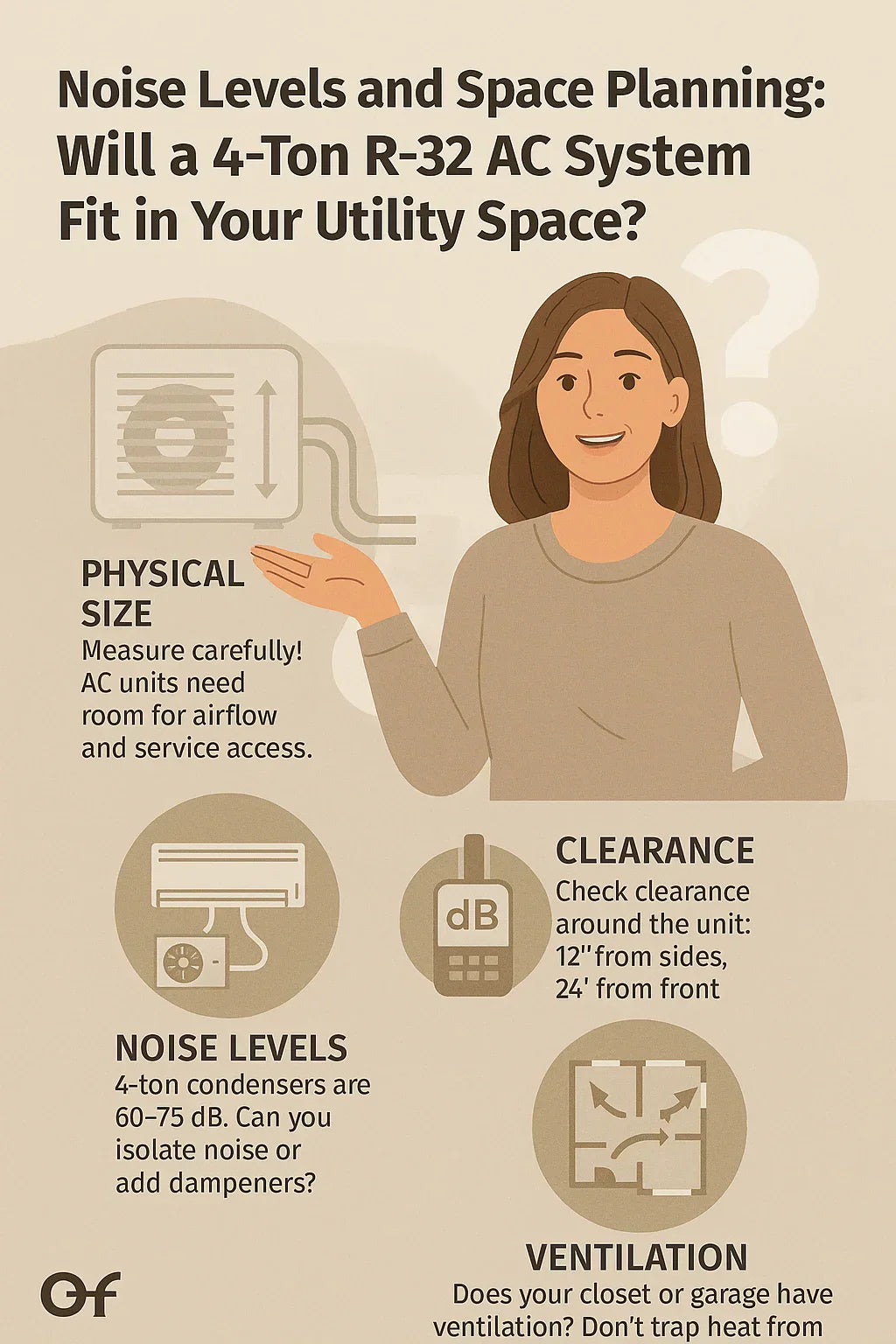Introduction: When Bigger Isn’t Always Better—Especially Indoors
Installing a 4-ton R-32 air conditioner in your home isn’t just about matching square footage to tonnage. It’s also about whether your utility space, closet, or mechanical room can accommodate it—without compromising airflow, clearance, or your sanity (hello, noise).
Savvy learned this the hard way when she upgraded to a high-efficiency 4-ton R-32 system for her 2,400 sq ft open-layout home. Let’s walk through what she discovered—and what you should check before making the same decision.
Section 1: The Physical Footprint of a 4-Ton R-32 AC System
How Big Is a 4-Ton System, Really?
While sizing charts often focus on cooling capacity, physical dimensions vary by model and brand. Here's what you're looking at with most residential R-32 systems:
-
Condenser: ~35–45 inches tall, 35–40 inches wide, 30–35 inches deep
-
Air handler/furnace combo (if applicable): ~50–60 inches tall, 18–24 inches wide, 20–24 inches deep
Savvy's air handler measured 58" H x 21" W x 22" D, and the condenser took up roughly 42" x 36" on the side of her home.
Key Tip: Don’t rely on your old unit’s footprint. R-32 systems often differ in coil size and cabinet width, so remeasure your space before ordering.
Section 2: Clearance Requirements—Airflow, Access & Code Compliance
Why Clearance Matters
Every AC system needs room to “breathe.” Too little clearance, and you’ll see:
-
Decreased efficiency
-
Higher noise levels
-
Premature compressor failure
-
Voided warranties (yes, really)
Standard Guidelines:
| Component | Minimum Clearance (Typical) |
|---|---|
| Sides of condenser | 12–24 inches |
| Rear of condenser | 6–12 inches |
| Above unit | 60 inches (open sky preferred) |
| Front access panel (air handler/furnace) | 30 inches |
Savvy originally had her condenser backed up against a fence—just 9 inches of space. Her installer flagged it, and they shifted it 18 inches forward to ensure proper ventilation.
Section 3: Utility Room Space Planning
Can It Even Fit Through the Door?
4-ton systems are often shipped in multiple pieces, but you still need enough space in your utility closet or basement for:
-
Delivery and maneuvering (at least 29" door width)
-
Installation access
-
Ongoing maintenance (filter changes, drain line checks)
Savvy had to remove a shelf and widen her utility room door by 2 inches to make it work.
Measure for the Following:
-
Unit depth + 30" front clearance
-
Minimum 3" on each side for service
-
Space for condensate lines, electrical disconnects, and refrigerant piping
Section 4: Noise Ratings—Will It Disrupt Your Living Space?
Understanding Sound Ratings (dB Levels)
R-32 systems are typically quieter than R-22 or older R-410A units—but size still correlates with sound.
| Component | Typical dB Range |
|---|---|
| Indoor air handler | 35–55 dB |
| Outdoor condenser | 60–75 dB |
For comparison:
-
40 dB = library
-
55 dB = quiet conversation
-
70 dB = vacuum cleaner
Savvy’s outdoor unit hit 66 dB at full load, which wasn’t a problem outdoors—but when her air handler kicked on near her laundry room, the vibration noise transferred through uninsulated drywall.
Noise Control Tips:
-
Isolate the unit with rubber pads or vibration dampeners
-
Seal penetrations where refrigerant lines enter the house
-
Insulate the return plenum if it shares walls with living areas
Section 5: Ventilation and Heat Rejection
Does Your Utility Closet Have Ventilation?
A tightly enclosed mechanical closet with no louvered doors or ducted return air can cause:
-
Overheating of components
-
Short-cycling
-
Poor indoor air quality
Savvy’s installer added a pass-through grille at the bottom of the door and an exhaust vent into her garage attic to give her system the airflow it needed.
Section 6: Real-World Alternatives If It Doesn’t Fit
If your space is too tight or noisy for a 4-ton system, consider:
-
Split system with vertical air handler in attic or garage
-
Horizontal unit in crawlspace
-
Ductless mini split for zoned cooling (e.g., MRCOOL or Mitsubishi)
You can still get R-32 efficiency with a setup tailored to your floor plan.
Savvy’s Lessons Learned
Here’s what Savvy says she’d do again (and what she’d avoid):
✅ Measure every wall, door, and obstruction—not just the floor footprint
✅ Ask for decibel ratings before buying
✅ Budget for venting upgrades
❌ Don’t assume “it’ll fit like the last one”
❌ Don’t skip clearance specs just because the unit “looks smaller”
Final Thoughts: Think Beyond BTUs
Before you upgrade to a 4-ton R-32 AC, take time to answer:
-
Does it physically fit my space?
-
Will it comply with airflow and safety codes?
-
Will the noise affect my comfort?
-
Do I need structural changes to accommodate it?
Efficiency means more than just energy savings—it also means installing the right unit in the right space.
In the next topic we will know more about: Is a 4-Ton R-32 AC System the Right Size for Your Home?







